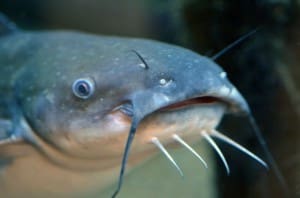11
May
White catfish (Ameiurus catus) spawning
By Virginia Fishes In Virginia Fishes
This video shows a pair of our many white catfish spawning. These two have fanned out a shallow depression underneath some woody debris with their tails. They perform a ritual where they swim in circles side by side until they eventually are ready to mate. They press their sides together head to tail-tail to head and curl their tails around each other. They do this repeatedly for several hours: she deposits eggs and he fertilizes them.
Catfish inhabit nearly every aquatic habitat across the world; a testament to their adaptability and biological success. As a group, they are one of the most important commercial food fishes and also extremely popular sport fishes, so it is no wonder catfish are so recognizable. Many tropical species are also quite popular in home aquaria (e.g. plecos, corydoras). Catfish are very recognizable because of their “whiskers” for which they are named. These are actually sensory organs – external taste buds – that help catfish detect food with amazing sensitivity..
The pale to white lower pairs of barbels help to distinguish the white catfish.
Brown bullheads have dark barbels.
In Virginia there are fifteen species of catfishes from two major Genera: the forked-tail catfishes Genus Ictalurus, and the bullheads Genus Ameiurus to which the white catfish (Ameiurus catus) belongs; within Ameiurus the subgenus Noturuscontains six small stream species of catfishes called madtoms. White catfishes are the largest of the bullheads and, unlike the larger forked-tail catfishes, are native to Virginia.
Brown bullhead Ameiurus nebulosus
Channel catfish (Ictalurus punctatus) were introduced in the late 1800’s, but the blue catfish (I. furcatus) and flathead catfish (I. puctatus) were introduced within the past fifty years, all as sport fish. Channels and blues especially have become so pervasive that they have out-competed the much smaller and less prolific white catfish in almost every body of water they share.












Nick
Were any fertile eggs collected? Any plans to raise some of the fry?